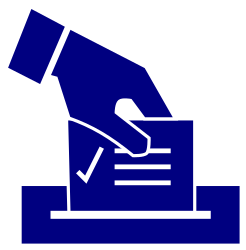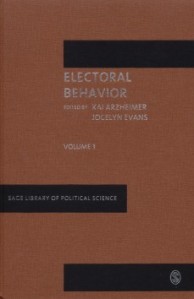As a subdiscipline, the study of electoral behavior (or “psephology”) begins with a handful of monographs that were published in the 1940s, 50s and 60s. It’s amazing to see how concepts and ideas that were developed in Downs’ “Economic Theory of Democracy” or in the “American Voter” by Campbell et al. some 50 years ago inform our work to the present day. However, the study of electoral behaviour (or electoral behavior – the publisher keep changing the title just to confuse me) did obviously not end with these holy books. From the 1960s on, the discipline was increasingly defined by a number of ground breaking articles that were published in professional journals.
This collection gave us the opportunity to bring together 66 articles which – in our humble view – define the discipline, represent important new departures, or bring together the knowledge we have on a given subject. As a friend of mine wisely remarked, at $ 950 the collection might be slightly underpriced. Then again, if you teach a course on electoral behaviour or political sociology, or if just want to get an overview of electoral studies, getting much if not most of the important stuff in one four-volume-1640-pages book is really a bargain. Maybe you should invite your librarian for a coffee. Make it a large one.
What the Library of Electoral Behaviour gives you is a full introduction to the study of electoral behaviour plus:
Socio-Political Models
Lipset, S. M. and S. Rokkan (eds.) (1967) [‘Introduction’] in Party Systems and Voter Alignments: Cross-National Perspectives, New York: The Free Press..
Erikson, Robert, John H. Goldthorpe and Lucienne Portocarero (1979), ‘Intergenerational Class Mobility in Three Western European Societies. England, France and Sweden’, British Journal of Sociology 30: 415-441
Alford, Robert R. (1962): A Suggested Index of the Association of Social Class and Voting, in: Public Opinion Quarterly 26, S. 417–425
Lijphart, Arend: Religious vs. Linguistic vs. Class Voting: The “Crucial Experiment” of Comparing Belgium, Canada, South Africa, and Switzerland, The American Political Science Review, Vol. 73, No. 2. (Jun., 1979), pp. 442-458.
Class Mobility and Political Preferences: Individual and Contextual Effects Nan Dirk De Graaf; Paul Nieuwbeerta; Anthony Heath The American Journal of Sociology, Vol. 100, No. 4. (Jan., 1995), pp. 997-1027.
The Developmental Theory of the Gender Gap: Women’s and Men’s Voting Behavior in Global Perspective Ronald Inglehart; Pippa Norris . (Oct., 2000), pp. 441-463.
Alan Zuckerman (1975) ‘Political Cleavage: a conceptual and theoretical analysis’, British Journal of Political Science, 5: 231-248.
Key, V. O. “A Theory of Critical Elections.” The Journal of Politics 17, no. 1 (1955): 3-18
Belknap, G., and A. Campbell. “Political Party Identification and Attitudes toward Foreign Policy.” The Public Opinion Quarterly 15, no. 4 (1951): 601-23.
Converse, P. (1966) ‘The concept of a normal vote’ in A. Campbell et al (eds.) Elections and the Political Order, New York, John Wiley.
Jennings, M.K. and R. Niemi (1968) ‘The transmission of political values from parent to child’, American Political Science Review, 62: 169-84.
Converse, Philip E. (1964), ‘The Nature of Belief Systems in Mass Publics’, in: David E. Apter (ed). Ideology and Discontent, pp. 206-261, New York: Free Press
Jackson, J. (1983). “The systematic beliefs of the mass public: estimating policy preferences with survey data” in Journal of Politics, vol. 45: 840-58.
Markus, Gregory B., and Philip E. Converse. “A Dynamic Simultaneous Equation Model of Electoral Choice.” The American Political Science Review 73, no. 4 (1979): 1055-70.
Fiorina, Morris P. “An Outline for a Model of Party Choice.” American Journal of Political Science 21, no. 3 (1977): 601-25.
Bartels, Larry M. “Partisanship and Voting Behavior, 1952-1996.” American Journal of Political Science 44 (2000): 35-50.
Cognition and the Voter Calculus
Hotelling, Harold (1929), ‘Stability in Competition’, The Economic Journal 39(153): 41-57.
Riker, William H., and Peter C. Ordeshook. “A Theory of the Calculus of Voting.” American Political Science Review 62 (1968): 25-42.

